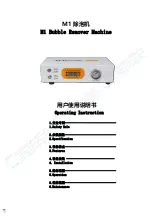
4-4
IM AQ1210-01EN
Explanation
Averaged Measurement (AVG)
In averaged measurements, the data that is acquired from each pulse is averaged and displayed as
a waveform. Averaged measurements improve the signal-to-noise (S/N) ratio. This is effective when
you want to detect faint events that are buried in noise.
Distance Range
With the auto setting, the instrument detects the open end (end point) at the start of an averaged
measurement and automatically calculates the length of the optical fiber cable. When setting the
distance range manually, set a distance range appropriate for the length of the optical fiber cable to
be measured. For details on the appropriate distance range, see section 2.1.
Pulse Width
With the auto setting, when the distance range is set to auto, the minimum pulse width that can
measure the distance to the open end (end point) is selected. When setting the pulse width
manually, set a pulse width appropriate for the distance range. For details on the appropriate pulse
width, see section 2.1.
Average Count and Average Duration
With the auto setting, the average method is selected according to the distance range and the loss
in the optical fiber cable being measured.
Attenuation
With the auto setting, an attenuation value is selected according to the distance range and the loss
in the optical fiber cable being measured. If you want to set the attenuation value manually, select a
value appropriate for the pulse width. For details on the attenuation value appropriate for the pulse
width, see section 2.1.
Switching the Display between TRACE Mode and MAP Mode
You can switch the data display screen.
TRACE mode: The data display screen shows the waveform of optical pulse measurement.
MAP mode: The data display screen shows the events detected through event analysis and
displays them with icons.
4.1 Measuring in TRACE Mode
















































